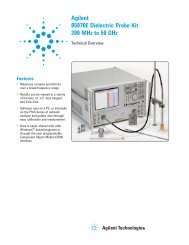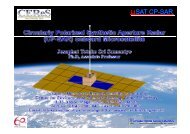You also want an ePaper? Increase the reach of your titles
YUMPU automatically turns print PDFs into web optimized ePapers that Google loves.
J.Oto.Ktrl.Inst (J.Auto.Ctrl.Inst) Vol 1 (2), 2009 ISSN : 2085-2517<br />
A simple neural network structure can be expressed in,<br />
y<br />
⎜<br />
⎛ n<br />
f W U + b⎟<br />
⎞<br />
⎝ i 1<br />
i i<br />
⎠<br />
= ∑ =<br />
W1, W2, ….Wn and Wb are neural network weighthing parameters. These values will be<br />
evaluated in each iteration process. U1, U2, ... Un are neural network inputs. Each one of<br />
them will be multiplied with weight W accordingly, which in turn will be summed and<br />
calculated with an activation function F. In result, the output Y will be known.<br />
3.3 Backpropagation Algorithm<br />
The main idea of this algorithm is to evaluate and modify the weights and bias in a way so<br />
the error value minimized. First step in this algorithm is choosing the cost function. Error is<br />
represented as the difference between desired output and output obtained from neural<br />
network learning. One of the cost functions used is the sum of quadratic error which defined<br />
in equation,<br />
( ) 2<br />
1<br />
E =<br />
2 ∑ O −<br />
d<br />
d y d<br />
(2)<br />
where Od and yd are the desired output and output obtained from neural network<br />
respectively. To minimize the cost function, the weights are evaluated with,<br />
∂E<br />
W(<br />
k + 1 ) = W(<br />
k)<br />
−η<br />
(3)<br />
∂W<br />
where W is weight, is learning rate and E is cost function in error quadratic form. On outer<br />
layer, the gradient of cost function to weight is,<br />
∂E<br />
∂W<br />
O<br />
dj<br />
= −<br />
32<br />
(1)<br />
d<br />
∑ ( Od<br />
− y d ) (4)<br />
O<br />
where is the weight connecting the d- neuron from outer layer to j-neuron from hidden<br />
layer.<br />
3.4 Identfication Using Neural Network<br />
System was identified with previous acquisited data in non real time condition. 2250<br />
number of data were used as turbine input and output, while guide vane opening was the<br />
input variable and turbine angular speed as the output variable. Time sampling used was<br />
0.1 seconds. Identification process was done using neural network. Assumed a first order<br />
system with time delay. Based on this apriori knowledge, a neural network structure can be<br />
formed to be identified.<br />
d<br />
∂y<br />
∂W<br />
Based on (1), Saguling turbine system model can be illustrated with Fig. 5,<br />
dj






